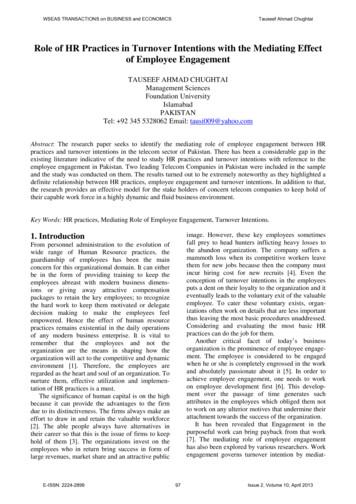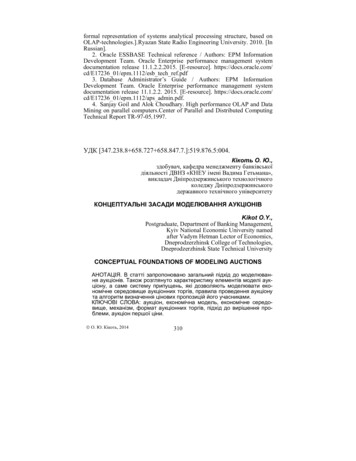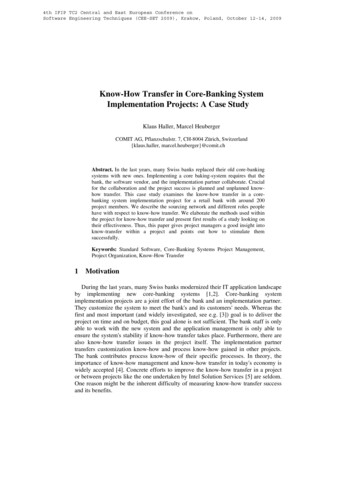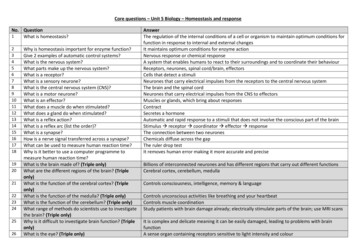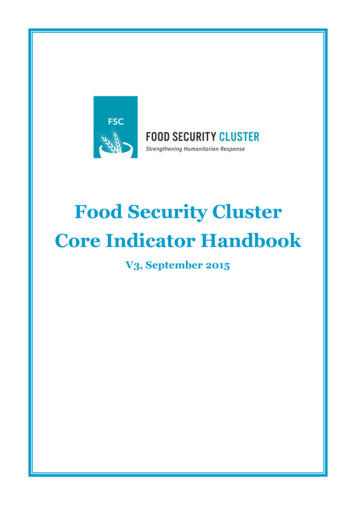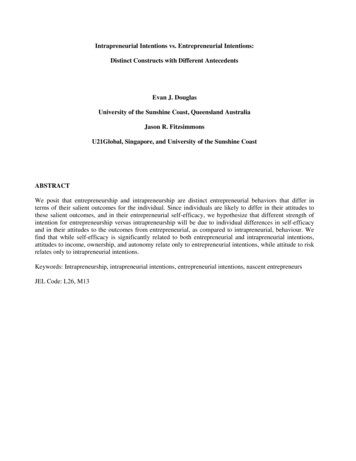
Transcription
Intrapreneurial Intentions vs. Entrepreneurial Intentions:Distinct Constructs with Different AntecedentsEvan J. DouglasUniversity of the Sunshine Coast, Queensland AustraliaJason R. FitzsimmonsU21Global, Singapore, and University of the Sunshine CoastABSTRACTWe posit that entrepreneurship and intrapreneurship are distinct entrepreneurial behaviors that differ interms of their salient outcomes for the individual. Since individuals are likely to differ in their attitudes tothese salient outcomes, and in their entrepreneurial self-efficacy, we hypothesize that different strength ofintention for entrepreneurship versus intrapreneurship will be due to individual differences in self-efficacyand in their attitudes to the outcomes from entrepreneurial, as compared to intrapreneurial, behaviour. Wefind that while self-efficacy is significantly related to both entrepreneurial and intrapreneurial intentions,attitudes to income, ownership, and autonomy relate only to entrepreneurial intentions, while attitude to riskrelates only to intrapreneurial intentions.Keywords: Intrapreneurship, intrapreneurial intentions, entrepreneurial intentions, nascent entrepreneursJEL Code: L26, M13
2INTRODUCTIONThe literature on entrepreneurial intentions has focused almost exclusively on the individual’s intention tobecome a self-employed owner-manager of a new business venture (see, for example, Bird, 1988, 1992;Krueger, 1993; Krueger & Carsrud, 1993; Krueger & Brazeal, 1994; Gupta, Turban, Wasti & Sikdar, 2009;Linan & Chen, 2009; Thompson, 2009; Fitzsimmons & Douglas, 2011). Yet entrepreneurial behavior is alsofound among employees within organisations, where it is known as intrapreneurship (Pinchot, 1985) andcontributes to corporate entrepreneurship at the firm level (Lumpkin & Dess, 1996; Morris & Kuratko,2002; Davidsson, 2006). Since both individual and corporate entrepreneurship are desirable for economicgrowth and global competitiveness, it is important to understand both types of entrepreneurship behavior(Burgelman, 1983; Honig, 2001; Parker, 2011). Burgelman (1983) examined the process of internalcorporate venturing conducted by intrapreneurs; Honig (2001) considered the different learning strategies ofentrepreneurs and intrapreneurs; and Parker (2011) examined factors promoting entrepreneurship rather thanintrapreneurship, but to date little theoretical or empirical research has considered the cognitive antecedentsof the individual’s intention to become an intrapreneur as compared to the cognitive antecedents ofentrepreneurial intentions, an exception being a limited exercise by Monsen, Patzelt & Saxton (2010).We know that entrepreneurial behavior takes place at the nexus of the individual and the opportunity,and that there is heterogeneity on both sides of this nexus (Shane & Venkataraman, 2000). Heterogeneityamong individuals has been well studied in the context of entrepreneurial intentions, with differences inattitudes to outcomes associated with entrepreneurial behaviour and the individual’s entrepreneurial selfefficacy being acknowledged as the main drivers of differences in entrepreneurial intentions (see forexample, Krueger & Brazeal, 1994; Krueger, Reilly & Carsrud, 2000). While some researchers (e.g.Samuelsson & Davidsson, 2009) have considered heterogeneity on the opportunity side, the literature hasalmost totally neglected the individual’s formation of the intention to behave entrepreneurially as anemployee within an existing firm. Prior research generally assumes that entrepreneurs and intrapreneurs areessentially similar in terms of their human capital (Parker, 2011: 27; Menzel, Aaltio, & Ulijn, 2007: 734),
3and that their risk attitudes and cognitive styles are also rather similar (Hisrich, 1990; Hitt, Ireland &Hoskisson, 2002). As Honig (2001: 22) states, “establishing differences between nascent entrepreneurs andnascent intrapreneurs is . of considerable theoretical and empirical interest”. Previous studies have alsoexamined the individual’s choice between self-employment and employment (Evans & Leighton, 1989;Katz, 1992; Kolvereid, 1996; Kolvereid, 1997; Reynolds, 1997; Shaver, Carter, Crosby, Bakalarova, &Gatewood, 2001; Douglas & Shepherd, 2002; Carter, Gartner, Shaver & Gatewood, 2003). Such studieshave generally proceeded on the basis of this simple dichotomy and have failed to recognise the intermediatecase where the individual, as an intrapreneur, can behave entrepreneurially as an employee within acorporate context. Shaver et al (2001) suggest a framework for analysing the reasons for starting a newbusiness, but do not consider the reasons for undertaking intrapreneurship. Carter et al (2003) compared thereasons for career choices of nascent entrepreneurs and non-entrepreneurs, but excluded those who were inthe process of starting a new venture in the context of their employer.While much has been written about how managers might motivate increased intrapreneurialbehaviour from employees in the corporate context (e.g. Hamel, 2000; Morris & Kuratko, 2002), little isknown about how employers might best select employees who have a propensity for intrapreneurship.Insight into the cognitive and human capital differences of those intending employment as an intrapreneurmight facilitate more efficient matching of individuals with corporate employment roles – some of theseroles might require intrapreneurial behavior while others are largely administrative with little scope forindividual initiative or creativity (Stevenson, 1994). Employers seeking intrapreneurial employees need tounderstand that recruiting individuals with strong intentions for entrepreneurship may not be the beststrategy as they may not dwell long in the corporate context before leaving to become self-employed.Second, policy makers need to understand that a different policy approach may be required toencourage individuals to create new ventures to introduce innovations as distinct from encouraging existingfirms to do this. Public policy to nurture and support fledgling firms may be pushing individuals who arebetter suited to intrapreneurship into entrepreneurial new ventures and thereby contribute to the waste ofpublic resources (Shane, 2009), not to mention the personal cost of entrepreneurial failure. Third,
4entrepreneurship education that is based on the premise of starting one’s own business may be missing thetarget for many potential intrapreneurs. In encouraging and equipping students to act entrepreneurially, wemay be teaching the wrong things, or at best, the right things in the wrong context. Educational institutionsthat teach entrepreneurship in one subset of courses, while teaching management, marketing, productionand operations, and so forth, in a corporate context, need to understand that potential intrapreneurs may notbe best served by either of these polar perspectives.While others have maintained a clear focus on intentions toward independent entrepreneurship, in thispaper we expand on their work by paying attention to both entrepreneurial intentions and intrapreneurialintentions and investigating the differences between these. We argue that entrepreneurship andintrapreneurship offer distinctly different benefit and cost outcomes. Since individuals are likely to differwith respect to their attitudes toward these outcomes, we might expect individuals to form a preference forone over the other based on their personal attitudes towards the salient outcomes and on their perceivedentrepreneurial abilities. Accordingly, the first research question addressed in this paper is whetherindividual entrepreneurship and corporate intrapreneurship are viewed by individuals as separate and distinctentrepreneurial behaviors. The second main research question is whether the antecedents of intrapreneurialintentions are the same as, or are different to, the antecedents for individual entrepreneurial intentions, andwe demonstrate empirically that there are important differences.In the following sections we address these questions and test empirically a series of hypothesessuggested by the literature and our analysis. We first examine the relevant literature on entrepreneurialintentions and its antecedents. Next follows a section on theory building and hypothesis development. Thenwe discuss our sample and research method, followed by details of our analysis and results. The paper endswith discussion of our contributions, limitations, and implications of our results.PRIOR RESEARCH ON ENTREPRENEURIAL INTENTIONS
5Previous research has investigated the economic and psychological motivations of individuals to behaveentrepreneurially (Baumol, 1990; Evans & Leighton, 1989; Katz, 1992; Krueger, 1993: Krueger & Carsrud,1993; Eisenhauer, 1995; Kolvereid, 1996, 1997; Douglas & Shepherd, 2000; Shaver et al, 2001; Markman,Balkin & Baron, 2002; Carter et al, 2003; McMullen & Shepherd, 2006). In this study we focus on theindividual’s formation of the intention to behave entrepreneurially as either a self-employed entrepreneur oran employed intrapreneur. Note that the focus of our analysis is at the intentions stage of the entrepreneurialprocess rather than at the following behavior stage. It nonetheless involves the individual’s expectationsabout the outcomes that would be experienced at that later stage in the entrepreneurial process. Note alsothat our analysis is at the individual level, rather than at the firm level – we do not address the collectiveintentions or actions of intrapreneurs in the process of corporate venturing (see, e.g. Burgelman, 1983).The ‘theory of planned behavior’ argues that behavior is best predicted by intentions toward thatbehavior. Intentions, in turn, depend on beliefs or attitudes towards the outcomes of that behavior, and ingeneral, the stronger are these attitudes, the greater is the intention to engage in that particular behavior(Fishbein & Ajzen, 1975; Ajzen, 1985, 1991). Bird (1988, 1992), Krueger (1993), Boyd & Vozikis (1995),and Bird & Jelinek (1998) argue that preceding the act of entrepreneurial behaviour is the formation of theintention to behave entrepreneurially. Krueger (1993), Krueger & Carsrud (1993), Krueger & Brazeal(1994), and Krueger, O’Rielly & Carsrud (2000) argue that the formation of entrepreneurial intentions bythe individual depends on the perceived desirability and the perceived feasibility of the entrepreneurialbehaviour. The perceived desirability of an entrepreneurial action depends, in turn, on the individual’sattitudes towards the outcomes of that action (Robinson, Simpson, Huefner & Hunt, 1991) in conjunctionwith the magnitude of those outcomes. Attitudes are feelings that individuals have toward objects orsituations that are either positive or negative and which vary in degree from ambivalent to very strong. Astrong positive attitude to an outcome implies that the individual expects to gain substantial psychicsatisfaction from experiencing that outcome, and this militates in favor of the individual subsequentlypursuing that action (Douglas & Shepherd, 2000).
6The salient outcomes of entrepreneurial behavior have been argued to include income, autonomy,exposure to risk, exposure to work effort, and all other net benefits (Douglas & Shepherd, 2000). In thispaper, for the purposes of potentially distinguishing different attitudinal antecedents of intrapreneurship, weargue that these are also the salient outcomes associated with behaving intrapreneurially. Also for thepurposes of directly comparing entrepreneurial intentions with intrapreneurial intentions, holding all elseequal, we assume that the wealth-creating opportunity is the same for both behavioural alternatives – i.e. itmight be exploited either by the individual forming a new business entity (i.e. entrepreneurship) or by theindividual working within an existing business firm (i.e. intrapreneurship). The quantum of each of thesalient outcomes may be perceived by individuals to be higher or lower when a given opportunity isexploited as an entrepreneur, as compared to exploiting the same opportunity as an intrapreneur.The salient outcomes, or the ‘payoffs’ to entrepreneurial activity (Baumol, 1990), include bothmonetary and intrinsic benefits and costs associated with entrepreneurial activity (Wiklund, Davidsson &Delmar, 2003). Eisenhauer (1995) called the intrinsic benefits and costs the ‘working conditions’ associatedwith entrepreneurship. Douglas & Shepherd (2000) specified the intrinsic costs as those relating to risktaking and providing work effort, and specified the intrinsic benefits as autonomy and all other netperquisites. McClelland (1961) argued that a major intrinsic benefit of entrepreneurial activity relates to asense of achievement, and several other authors consider a range of intrinsic benefits that are (in prospect) orwere (in retrospect) expected to be attained as a result of becoming an entrepreneur (see for exampleScheinberg & MacMillan, 1988; Birley & Westhead, 1994; Gatewood, Shaver & Gartner, 1995; Kolvereid1996, 1997; Shaver et al, 2001; and Carter et al, 2003). Shaver et al (2001:8) mention the “fundamentalelements of independence and ownership” as salient outcomes of entrepreneurship, and Fitzsimmons andDouglas (2011) found that attitude to ownership of the firm is a distinctly separate construct to attitude toindependence. Wiklund et al. (2003) found separate and significant positive effects for attitude toindependence and attitude to control, as well for attitude to income and attitude to employee well-being, asdeterminants of the growth motivation of small business managers.
7Several studies have examined the reasons why individuals choose to pursue entrepreneurial selfemployment rather than non-entrepreneurial employment situations (e.g. Scheinberg & MacMillan, 1988;Birley & Westhead, 1994; Gatewood et al, 1995; Shaver et al, 2001; Carter et al, 2003). Although thedescriptors differ across this prior research
intention for entrepreneurship versus intrapreneurship will be due to individual differences in self-efficacy and in their attitudes to the outcomes from entrepreneurial, as compared to intrapreneurial, behaviour. We find that while self-efficacy is significantly related to both entrepreneurial and intrapreneurial intentions,
